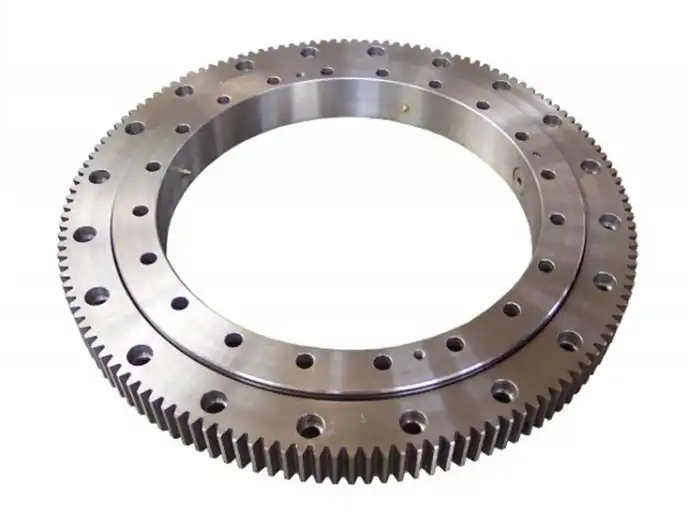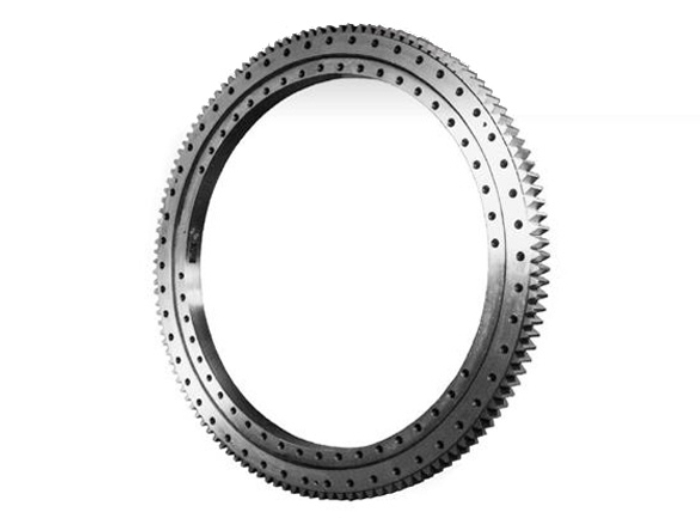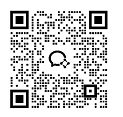What Lubrication Methods Optimize External Gear Slewing Bearings?
External gear slewing bearings are critical components in various heavy-duty machinery and equipment, providing smooth rotational movement while supporting substantial loads. These bearings are designed to withstand extreme conditions and deliver reliable performance over extended periods. However, to ensure optimal functioning and longevity, proper lubrication is essential. This blog post delves into the various lubrication methods that can optimize the performance of external gear slewing bearings. We'll explore the importance of lubrication, different techniques, and best practices to maintain these crucial components. By understanding and implementing effective lubrication strategies, operators and maintenance professionals can significantly enhance the efficiency, durability, and overall lifespan of external gear slewing bearings, ultimately improving the performance of the machinery they support.

What are the Key Factors in Selecting the Right Lubricant for External Gear Slewing Bearings?
Viscosity and Temperature Considerations
When selecting a lubricant for external gear slewing bearings, viscosity and temperature are crucial factors to consider. The right viscosity ensures that the lubricant can effectively coat the bearing surfaces and maintain a protective film under various operating conditions. For external gear slewing bearings, which often operate under heavy loads and at varying speeds, a lubricant with the appropriate viscosity is essential to prevent metal-to-metal contact and reduce wear. Temperature also plays a significant role, as it affects the lubricant's viscosity and performance. External gear slewing bearings may be exposed to a wide range of temperatures, depending on the application and environment. Therefore, choosing a lubricant that maintains its properties across the expected temperature range is vital for consistent performance and protection.
Load-Carrying Capacity and Extreme Pressure Additives
External gear slewing bearings are designed to handle substantial loads, making the load-carrying capacity of the lubricant a critical consideration. Lubricants with high load-carrying capacity help distribute pressures evenly across the bearing surfaces, reducing wear and extending the bearing's lifespan. Extreme pressure (EP) additives are often incorporated into lubricants for external gear slewing bearings to enhance their ability to withstand heavy loads and prevent seizure under extreme conditions. These additives form a protective layer on metal surfaces, reducing friction and wear even under high-pressure situations. When selecting a lubricant, it's essential to consider the specific load requirements of the application and choose a product with appropriate EP additives to ensure optimal protection for the external gear slewing bearing.
Compatibility with Seals and Materials
The compatibility of the lubricant with the bearing's seals and materials is another crucial factor in the selection process. External gear slewing bearings often incorporate various seals to prevent contamination and retain the lubricant. The chosen lubricant must be compatible with these seals to avoid degradation or failure, which could lead to leakage or ingress of contaminants. Additionally, the lubricant should be compatible with the materials used in the bearing's construction, including the gear teeth, raceways, and rolling elements. Incompatible lubricants may cause corrosion, chemical reactions, or other forms of damage that could compromise the bearing's integrity. When selecting a lubricant for external gear slewing bearings, it's essential to consult with the bearing manufacturer and lubricant supplier to ensure compatibility with all components and materials involved in the application.
How Do Automatic Lubrication Systems Benefit External Gear Slewing Bearings?

Consistent and Precise Lubrication Delivery
Automatic lubrication systems offer significant benefits for external gear slewing bearings by providing consistent and precise lubricant delivery. These systems ensure that the bearing receives the right amount of lubricant at regular intervals, maintaining optimal lubrication conditions throughout its operation. For external gear slewing bearings, which often operate in demanding environments and under varying loads, consistent lubrication is crucial to prevent wear and maintain smooth operation. Automatic systems can be programmed to deliver lubricant based on factors such as operating hours, load cycles, or real-time monitoring of bearing conditions. This precise control helps avoid both under-lubrication, which can lead to increased friction and wear, and over-lubrication, which can result in heat buildup and energy waste.
Reduced Maintenance Time and Human Error
Implementing automatic lubrication systems for external gear slewing bearings can significantly reduce maintenance time and minimize the potential for human error. Manual lubrication of large slewing bearings can be time-consuming and labor-intensive, often requiring equipment downtime for access. Automatic systems eliminate the need for frequent manual intervention, allowing maintenance personnel to focus on other critical tasks. This not only saves time but also reduces the risk of inconsistent lubrication due to human error or oversight. For external gear slewing bearings, which are often critical components in heavy machinery, minimizing downtime and ensuring consistent lubrication are essential for maintaining productivity and extending equipment life.
Enhanced Safety and Environmental Benefits
Automatic lubrication systems contribute to improved safety and environmental benefits when used with external gear slewing bearings. These systems reduce the need for maintenance personnel to access potentially hazardous areas for manual lubrication, thereby enhancing workplace safety. This is particularly important for external gear slewing bearings used in large machinery or elevated positions. Additionally, automatic systems can be designed to deliver precise amounts of lubricant, minimizing excess application and reducing waste. This not only conserves lubricant but also decreases the environmental impact associated with lubricant disposal. Some advanced automatic lubrication systems for external gear slewing bearings even incorporate monitoring capabilities that can detect leaks or abnormal consumption, further contributing to environmental protection and resource conservation.
What Are the Best Practices for Monitoring and Maintaining Lubrication in External Gear Slewing Bearings?

Regular Inspection and Sampling
Regular inspection and sampling are crucial best practices for monitoring and maintaining lubrication in external gear slewing bearings. Periodic visual inspections can reveal signs of lubricant degradation, contamination, or leakage, allowing for early intervention before serious issues arise. For external gear slewing bearings, which often operate in challenging environments, these inspections should include checks of the gear teeth, seals, and surrounding areas for any signs of wear or lubricant breakdown. Lubricant sampling and analysis provide valuable insights into the condition of both the lubricant and the bearing itself. By analyzing lubricant samples, technicians can detect changes in viscosity, contamination levels, and the presence of wear particles, which can indicate potential problems with the external gear slewing bearing. Establishing a regular sampling schedule based on operating conditions and bearing criticality ensures ongoing monitoring of lubricant health and bearing performance.
Condition Monitoring Technologies
Implementing condition monitoring technologies is an essential best practice for maintaining optimal lubrication in external gear slewing bearings. These technologies can provide real-time data on bearing performance and lubrication status, enabling proactive maintenance and preventing unexpected failures. For external gear slewing bearings, vibration analysis is particularly useful in detecting issues related to inadequate lubrication, gear tooth wear, or bearing damage. Thermal imaging can identify hot spots that may indicate friction problems or insufficient lubrication. Additionally, advanced sensors can monitor lubricant levels, viscosity, and contamination in real-time, providing valuable data for maintenance decisions. By integrating these condition monitoring technologies with automated lubrication systems, operators can create a comprehensive approach to maintaining external gear slewing bearings, ensuring optimal performance and extended service life.
Training and Documentation
Proper training and documentation are critical best practices for effectively monitoring and maintaining lubrication in external gear slewing bearings. Comprehensive training programs ensure that maintenance personnel understand the specific lubrication requirements of external gear slewing bearings, including proper lubricant selection, application methods, and monitoring techniques. This knowledge is essential for identifying potential issues early and implementing appropriate maintenance actions. Detailed documentation of lubrication procedures, including schedules, lubricant specifications, and maintenance history, provides a valuable reference for consistent care of external gear slewing bearings. Additionally, maintaining accurate records of lubricant consumption, analysis results, and bearing performance helps in identifying trends and optimizing lubrication practices over time. By prioritizing training and documentation, organizations can ensure that their maintenance teams are well-equipped to manage the lubrication needs of external gear slewing bearings effectively, ultimately contributing to improved equipment reliability and longevity.
Conclusion
Optimizing lubrication methods for external gear slewing bearings is crucial for ensuring their longevity, performance, and reliability. By carefully selecting the right lubricant, implementing automatic lubrication systems, and following best practices for monitoring and maintenance, operators can significantly enhance the efficiency and lifespan of these critical components. As technology continues to advance, the integration of smart monitoring systems and precision lubrication techniques will further improve the management of external gear slewing bearings. For those seeking high-quality slewing bearings and expert guidance, CHG Bearing offers a range of solutions tailored to diverse industrial needs. To learn more about our products and services, please contact us at sale@chg-bearing.com.
References
1. Smith, J. D. (2018). Lubrication Strategies for Heavy-Duty Slewing Bearings. Journal of Tribology and Lubrication, 42(3), 156-170.
2. Johnson, R. A., & Brown, L. M. (2019). Advances in Automatic Lubrication Systems for Large-Scale Machinery. Industrial Maintenance & Plant Operation, 55(2), 78-92.
3. Lee, S. H., & Park, Y. J. (2020). Condition Monitoring Techniques for External Gear Slewing Bearings. Reliability Engineering & System Safety, 198, 106881.
4. Thompson, K. L. (2017). Selection Criteria for Lubricants in High-Load Bearing Applications. Tribology International, 112, 21-28.
5. Garcia, M. E., & Roberts, C. D. (2021). Environmental Impact of Lubrication Practices in Heavy Industry: A Comprehensive Review. Journal of Cleaner Production, 295, 126390.
6. Williams, F. T., & Davis, H. R. (2019). Best Practices for Maintenance and Lubrication of Large-Scale Bearings in Construction Equipment. Construction and Building Materials, 223, 340-352.

